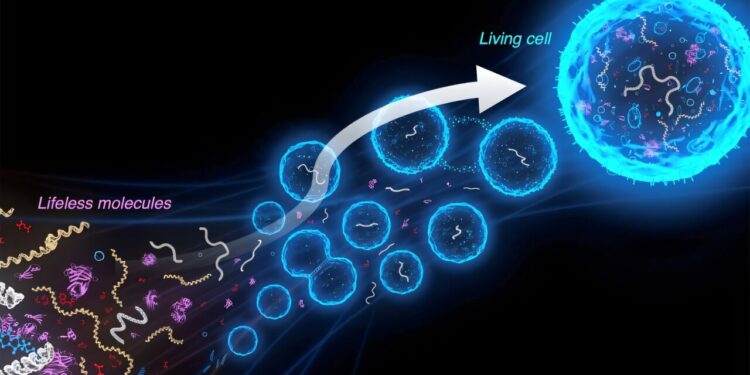A simplified synthetic equivalent of a cell would be like a model of life. Credit: EVOLF project
It’s one of the most fundamental questions in science: how can lifeless molecules come together to form a living cell? Bert Poolman, professor of biochemistry at the University of Groningen, has been working on this problem for more than 20 years. It aims to understand life by trying to reconstruct it; it builds simplified artificial versions of biological systems that can be used as components of a synthetic cell.
Poolman published two articles in Nature Nanotechnology And Natural communications. In the first article he describes a system for converting energy and cross-feeding the products of this reaction between synthetic cells, while he describes a system for concentrating and converting nutrients in cells in the second article.
Six Dutch research institutes are collaborating in the BaSyc (Building a Synthetic Cell) consortium to build the elements needed for a synthetic cell. Poolman’s group works on energy conversion.
The real equivalents that it aims to reproduce are the mitochondria, the “energy factories” of the cell. These use the ADP molecule to produce ATP, which is the standard “fuel” that cells need to function. When ATP is converted back to ADP, energy is released and used to drive other processes.
Artificial energy plants
“Instead of hundreds of components in mitochondria, our energy conversion system uses only five,” Poolman explains. “We decided to simplify it as much as possible.” This may seem strange, because evolution has done an excellent job of producing functional systems.
“However, evolution is a one-way street, it builds on existing components, which often makes the outcome very complex,” says Poolman. An artificial replica, on the other hand, can be designed based on a specific outcome.
The five components were placed in vesicles, tiny cell-like sacs capable of absorbing ADP as well as the amino acid arginine from the surrounding fluid. Arginine is “burned” (deaminated) and thus provides the energy necessary to produce ATP, which is secreted by the vesicle.
“Of course, simplification comes at a price: we can only use arginine as an energy source, while cells use all kinds of different molecules, like amino acids, fats and sugars.”
Next, the Poolman group designed a second vesicle capable of absorbing secreted ATP and using it to trigger an energy-consuming reaction. Energy is provided by transforming ATP into ADP, which is then secreted and can be taken up by the first vesicle, thus closing the loop.
Such a cycle of ATP production and use forms the basis of metabolism in every living cell and drives the “machinery” necessary for energy-consuming reactions such as growth, cell division, protein synthesis, replication. DNA, etc.
ATP production in a mitochondrion, requiring >100 proteins, and synthetic vesicles producing ATP, with only 5 proteins. Credit: University of Groningen, Poolman laboratory
An artificial pumping system
The second module Poolman created was a little different: a vesicle in which a chemical process causes the interior to accumulate a negative charge and, in doing so, form an electrical potential, similar to that of an electronic circuit. The electric potential is used to couple the movement of charge to the accumulation of nutrients inside the vesicle, which is carried out by transporters.
These proteins present in the vesicle membrane work a bit like a waterwheel: positively charged protons pass through it from the outside of the vesicle to the negatively charged inside. This flow carries the transporter which, in this case, imports a sugar molecule, lactose. Again, this is a very common process in living cells, requiring many components that Poolman and his team mimicked with just two components.
When he submitted a paper describing this system, a reviewer asked if he couldn’t do something with the transported lactose, because cells use nutrients like this to produce useful building blocks. Poolman took on the challenge and added three additional enzymes to the system, which oxidized the sugar and allowed the production of the coenzyme NADH.
“This helper molecule plays an essential role in the proper functioning of all cells,” Poolman explains. “And by adding NADH production, we have shown that it is possible to expand the system.”
But what about the synthetic cell?
Having a simplified synthetic equivalent of two key features of life is fascinating, but many other steps must be integrated to form a synthetic cell with autonomous growth and division. “The next step we want to take is to add our metabolic energy production systems to a synthetic cell division system created by colleagues,” says Poolman.
The BaSyc program is entering its final years; funding for a new program was recently secured.
This EVOLF project is expected to last another 10 years and aims to find out how many additional lifeless modules can come together and create living cells.
“Ultimately, this would give us a model of life, something that is currently lacking in biology,” concludes Poolman. “This could potentially have all sorts of applications, but it would also help us better understand what life is.”
More information:
Laura Heinen et al, Synthetic synthesis for cross-feeding of adenine nucleotides between metabolically active nanoreactors, Nature Nanotechnology (2024). DOI: 10.1038/s41565-024-01811-1
Miyer F. Patiño-Ruiz et al, Chemiosmotic transport of nutrients in synthetic cells powered by an electrogenic antiport coupled to decarboxylation, Natural communications (2024). DOI: 10.1038/s41467-024-52085-z
Provided by the University of Groningen
Quote: Creating a simplified life form: scientists build modules for a synthetic cell (October 21, 2024) retrieved October 21, 2024 from
This document is subject to copyright. Except for fair use for private study or research purposes, no part may be reproduced without written permission. The content is provided for informational purposes only.



